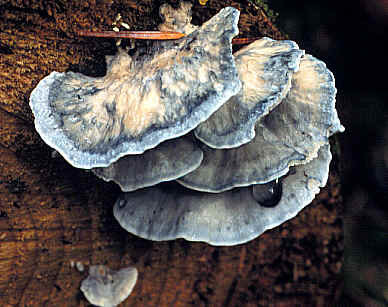Postia bluish-gray (Postia caesia)
- Division: Basidiomycota (Basidiomycetes)
- Subdivision: Agaricomycotina (Agaricomycetes)
- Class: Agaricomycetes (Agaricomycetes)
- Subclass: Incertae sedis (of uncertain position)
- Order: Polyporales (Polypore)
- Family: Fomitopsidaceae (Fomitopsis)
- Genus: Postia (Postiya)
- Type: Postia caesia (Postia bluish-gray)
- Oligoporus bluish gray
- Postia bluish gray
- Postia grey-blue
- Oligoporus bluish gray;
- Postia bluish gray;
- Postia grey-blue;
- Bjerkandera caesia;
- Boletus cassius;
- Oligoporus caesius;
- Polyporus caesiocoloratus;
- Polyporus ciliatulus;
- Tyromyces caesius;
- Leptoporus caesius;
- Polyporus caesius;
- Polystictus caesius;

The fruit bodies of the bluish-gray postia consist of a cap and a stem. The leg is very small, sessile, and the fruiting body is half-shaped. The bluish-gray postia is characterized by a wide prostrate part, fleshy and soft structure.
The cap is white on top, with small bluish spots in the form of spots. If you press hard on the surface of the fruiting body, then the flesh changes its color to a more intense one. In immature mushrooms, the skin is covered with an edge in the form of bristles, but as the mushrooms ripen, it becomes bare. The pulp of mushrooms of this species is very soft, white in color, under the influence of air it becomes blue, greenish or grayish. The taste of the bluish-gray postia is insipid, the flesh is characterized by a barely noticeable aroma.
The hymenophore of the fungus is represented by a tubular type, has a grayish, bluish or white color, which becomes more intense and saturated under mechanical action. The pores are characterized by their angularity and large size, and in mature mushrooms they acquire an irregular shape. The tubules of the hymenophore are long, with jagged and very uneven edges. Initially, the color of the tubes is whitish, and then becomes fawn with a bluish tint. If you press on the surface of the tube, then its color changes, darkens to bluish-gray.
The length of the cap of the bluish-gray postia varies within 6 cm, and its width is about 3-4 cm. In such mushrooms, the cap often grows together with the leg sideways, has a fan-shaped shape, is covered with visible villi on top, and is fibrous. The color of the mushroom cap is often grayish-blue-green, sometimes lighter at the edges, with yellowish tints.
You can meet a bluish-gray postia in the summer and autumn months (between July and November), mainly on the stumps of deciduous and coniferous trees, on tree trunks and dead branches. The fungus is found infrequently, mostly in small groups. You can see the bluish-gray postia on the dying wood of willow, alder, hazel, beech, fir, spruce and larch.
There are no toxic and poisonous substances in the fruiting bodies of Postia bluish-gray, however, this type of mushroom is very hard, so many mushroom pickers say that they are inedible.
In mushroom growing, several close varieties with a bluish-gray post are known, differing in ecology and some microscopic features. For example, Postia bluish-gray has the difference that the fruiting bodies of the fungus do not turn blue when touched. You can also confuse this mushroom with alder postia. True, the latter differs in its place of growth, and is found mainly on alder wood.









